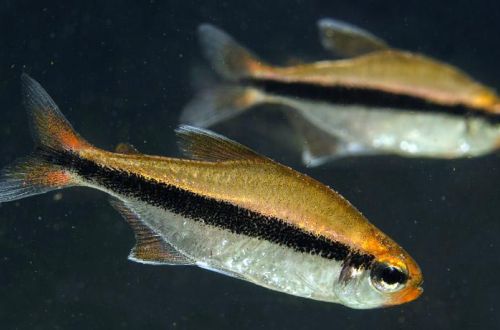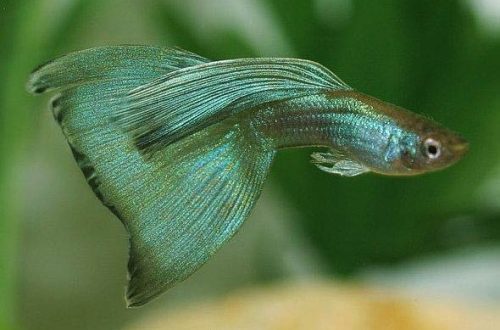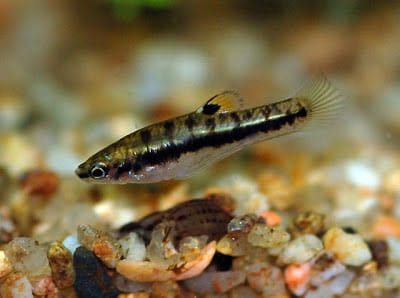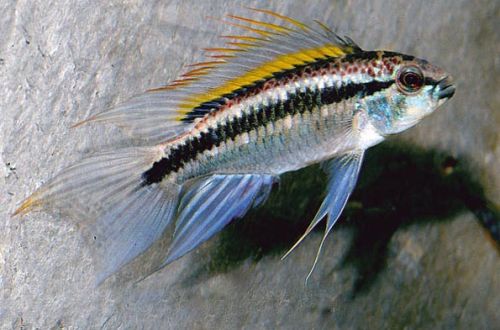
Double band Apistogram
Apistogramma biteniata or Bistripe Apistogramma, scientific name Apistogramma bitaeniata, belongs to the Cichlidae family. A bright mobile fish, the males of which are distinguished by a difficult disposition, which requires great attention to the choice of neighbors. Otherwise unpretentious, easy to keep and breed

Contents
Habitat
It comes from South America from the territory of Peru, Colombia and the state of Amazonas in Brazil. Inhabits the upper Amazon basin, in particular the Marañon, Ucayali and Solimões rivers and their tributaries. Occurs in sections of rivers with a slow flow, backwaters, floodplain areas with a large number of snags. The bottom is usually covered with a layer of fallen sheets. A characteristic feature of the natural habitat is the brown color of the water, it is given by tannins formed as a result of the decomposition of organic matter.
Brief information:
- The volume of the aquarium – from 50 liters.
- Temperature – 22-29°C
- Value pH — 4.5–7.0
- Water hardness – 0–5 dGH
- Substrate type – sandy
- Lighting – subdued
- Brackish water – no
- Water movement is weak
- The size of the fish is 5–7 cm.
- Food – small sinking food from a variety of products
- Temperament – peaceful, except during spawning periods
- Keeping in a harem with one male and several females
Description
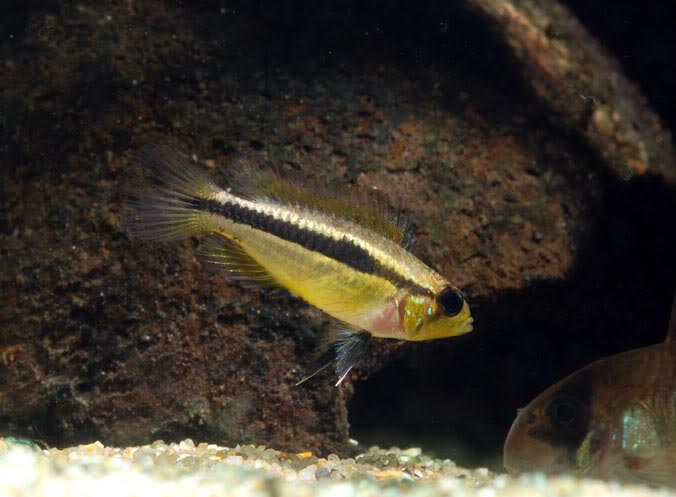
Adult individuals reach a length of 5–7 cm. A characteristic feature is the presence of dark horizontal stripes on the body of the fish. Males are larger and brighter colored. The body is silvery. Elongated large fins and a bluish tail. The dorsal fin stretches from head to tail, its base and tips are yellow, the middle is translucent. The females are smaller in size. The main color is yellow, the fins and tail have the same shade. The pelvic fins are dark.
It is worth noting that the color may vary, depending on the specific region of origin and the degree of hybridization. For example, people from the Brazilian section of the rivers have more yellow hues, while representatives from Peru have more blue.
Food
Omnivorous species. The home aquarium will accept most popular aquarium fish foods such as dry flakes, pellets, frozen or live brine shrimp, daphnia, bloodworms. The most preferred are special foods for South American cichlids, which combine all the necessary additives, including color enhancers.
Maintenance and care, arrangement of the aquarium
The minimum allowable size of an aquarium for one or two fish starts from 50–60 liters. Captive-bred fish are unpretentious in terms of decoration and can even live in a half-empty tank, where they actually are in many pet stores before being sold. However, in the long run, this will cause the color to fade.
The two-striped Apistogramma will look much more harmonious among the design, reminiscent of its natural habitat. It is recommended to use a sandy substrate, many snags and aquatic plants from which form areas where you can hide. The lighting is subdued. If breeding is planned, then reliable shelters should be provided in the form of caves, grottoes, where females will temporarily hide with fry.
Experienced aquarists use the leaves of some trees to give the design more naturalness and the necessary chemical composition of the water. The latter is achieved through the release of tannins by the leaves in the process of their decomposition, as happens in nature. Read more in the article “Which tree leaves can be used in an aquarium.” A similar effect can be achieved using filters based on peat or any other substance that acidifies water in the filtration system.
Successful keeping largely depends on maintaining stable water conditions within the range of temperatures and hydrochemical values acceptable for a particular fish species. To this end, the aquarium is equipped with the necessary equipment (filters, heaters, aerators, etc.) and regular maintenance procedures are carried out. The latter include at least the following actions: weekly replacement of part of the water (10–15% of the volume) with fresh water, checking it for dangerous concentrations of nitrogen cycle products (ammonia, nitrites, nitrates), removal of organic waste, equipment maintenance, etc. d.
Behavior and Compatibility
Males are territorial and very belligerent towards each other, so only one male should be kept in a small aquarium. During the mating season, behavior becomes unpredictable; at the end of spawning, when the female retires to a shelter, it is advisable to temporarily relocate the male. Females are peaceful and can be in a group. The best option is one male and several females.
Compatible with non-aggressive fish species of comparable size, with the exception of other Apistogrammes.
Breeding / breeding
In favorable conditions, breeding will not be difficult. The only problem may be the behavior of the male / males, which sometimes show “signs of attention” to females too actively. The worst case scenario is when she is alone in a small aquarium and has nowhere to hide, in which case injuries cannot be avoided.
The female lays eggs in some kind of shelter and stays nearby for protection. The fry that have appeared also remain under guardianship for some time, until they become large enough.
Fish diseases
The main cause of diseases lies in the conditions of detention, if they go beyond the permissible range, then immunity suppression inevitably occurs and the fish becomes susceptible to various infections that are inevitably present in the environment. If the first suspicions arise that the fish is sick, the first step is to check the water parameters and the presence of dangerous concentrations of nitrogen cycle products. Restoration of normal/suitable conditions often promotes healing. However, in some cases, medical treatment is indispensable. Read more about symptoms and treatments in the Aquarium Fish Diseases section.



